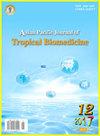双氯芬酸与胡椒碱和D-柠檬烯联合诱导乳腺癌症细胞凋亡和细胞周期阻滞
IF 1.7
4区 医学
Q3 TROPICAL MEDICINE
引用次数: 0
摘要
目的:研究双氯芬酸与胡椒碱和D-柠檬烯协同作用对癌症MCF-7细胞凋亡和细胞周期阻滞的潜在作用。方法:通过分子对接研究,评价双氯芬酸与哌啶和D-柠檬烯对p53、Bax和Bcl-2的结合亲和力。MTT法测定IC50,Chou-Talay法测定双氯芬酸加胡椒碱和双氯芬酸加D-柠檬烯联合处理的协同浓度。细胞凋亡检测、细胞周期阻滞、活性氧产生和线粒体膜电位也进行了研究。结果:双氯芬酸、胡椒碱和D-柠檬烯对p53、Bax和Bcl-2表现出强大的结合亲和力。双氯芬酸加胡椒碱和双氯芬酸加D-柠檬烯增强了活性氧的形成,这也对线粒体膜的完整性产生了影响,并导致DNA断裂。双氯芬酸加胡椒碱和双氯芬酸加D-柠檬烯使细胞停滞在亚G0期,同时显著降低G2/M期细胞的百分比。此外,膜联蛋白V/碘化丙啶染色证实了联合治疗中细胞凋亡的增加。结论:与双氯芬酸、胡椒碱和D-柠檬烯单独治疗相比,联合治疗显著增强了对MCF-7细胞的抗增殖和凋亡作用。本文章由计算机程序翻译,如有差异,请以英文原文为准。
Combinatorial effect of diclofenac with piperine and D-limonene on inducing apoptosis and cell cycle arrest of breast cancer cells
Objective: To investigate the potential synergistic activity of diclofenac with piperine and D-limonene in inducing apoptosis and cell cycle arrest in breast cancer MCF-7 cells. Methods: Molecular docking study was conducted to evaluate the binding affinity of diclofenac with piperine and D-limonene against p53, Bax, and Bcl-2. The MTT assay was used to determine IC50, and the Chou-Talay method was used to determine the synergistic concentration of the combination treatment of diclofenac plus piperine and diclofenac plus D-limonene. Apoptosis detection, cell cycle arrest, reactive oxygen species production, and mitochondrial membrane potential were also investigated. Results: Diclofenac, piperine, and D-limonene showed potent binding affinity for p53, Bax, and Bcl-2. Diclofenac plus piperine and diclofenac plus D-limonene enhanced the formation of reactive oxygen species, which also had an effect on the mitochondrial membrane's integrity and caused DNA fragmentation. Diclofenac plus piperine and diclofenac plus D-limonene arrested the cells in the sub-G0 phase while drastically lowering the percentage of cells in the G2/M phase. Furthermore, the elevated apoptosis in the combined therapy was confirmed by annexin V/propidium iodide staining. Conclusions: The combined therapy prominently enhanced the anti-proliferative and apoptotic effects on MCF-7 cells compared with treatment with diclofenac, piperine, and D-limonene alone.
求助全文
通过发布文献求助,成功后即可免费获取论文全文。
去求助
来源期刊

Asian Pacific journal of tropical biomedicine
Biochemistry, Genetics and Molecular Biology-Biochemistry, Genetics and Molecular Biology (miscellaneous)
CiteScore
3.10
自引率
11.80%
发文量
2056
审稿时长
4 weeks
期刊介绍:
The journal will cover technical and clinical studies related to health, ethical and social issues in field of biology, bacteriology, biochemistry, biotechnology, cell biology, environmental biology, microbiology, medical microbiology, pharmacology, physiology, pathology, immunology, virology, toxicology, epidemiology, vaccinology, hematology, histopathology, cytology, genetics and tropical agriculture. Articles with clinical interest and implications will be given preference.
 求助内容:
求助内容: 应助结果提醒方式:
应助结果提醒方式:


